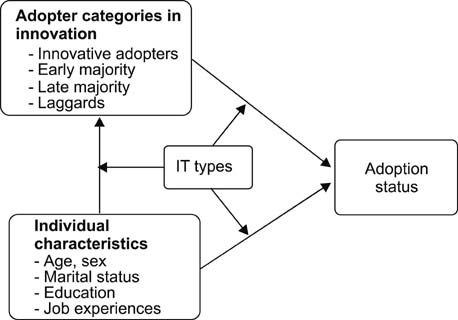Healthc Inform Res.
2010 Dec;16(4):290-298. 10.4258/hir.2010.16.4.290.
Impacts of Individual Innovativeness on the Acceptance of IT-based Innovations in Health Care Fields
- Affiliations
-
- 1Department of Health Care Administration, Kosin University, Busan, Korea. jpark@kosin.ac.kr
- 2Department of Medical Service Manager, Dong Pusan College University, Busan, Korea. kimhs@dpc.ac.kr
- KMID: 2284542
- DOI: http://doi.org/10.4258/hir.2010.16.4.290
Abstract
OBJECTIVES
The purpose of this study is to identify the role of individual innovation to demographic variables for determining IT adoption behaviors. This study also examines the effect of individual innovation on IT adoption behaviors across IT types.
METHODS
To verify the invariant effect of individual innovativeness, two groups of persons working in the health care field were surveyed. The first study subject group was radiologists and their adoption of e-purchasing the second group was emergency rescue crews and their adoption of GPS.
RESULTS
Adopter categories in innovations (ACI) as the measurement of individual innovation were a significant variable in both studies. Innovative adopters were more likely to use new IT tools than the majority of early adopters, and the early majority was more likely to adopt IT than the laggards. After merging the two data sets into one for testing the role of IT types as a moderator, the significance of ACI did not change, compared to the two separate analyses. In the merged data set, innovative adopters were 2.34 times more likely to be adopters than the early majority. The early majority was 2.32 times more likely to be adopters than laggards. Moreover, there were no moderating effects of IT types. Thus, there were no reversed adoption rates according to levels of ACI and demographic variables.
CONCLUSIONS
ACI has invariant effects on IT adoption behaviors regardless of IT types and demographic differences. To implement a new innovation, understanding individual innovativeness will provide more sophisticated implementation strategies for health care organizations and appropriate education programs for their employees.
Keyword
Figure
Cited by 1 articles
-
Impacts of Hospitals' Innovativeness on Information System Outsourcing Decisions
Jae Sung Park
Healthc Inform Res. 2014;20(2):135-144. doi: 10.4258/hir.2014.20.2.135.
Reference
-
1. Chae YM. Analysis of international trends in health information systems and its implication for national policy in Korea. 2005. Seoul: Ministry for Health, Welfare and Family Affair;208.2. Kim MY. Productivity paradox of ICT: debates revisited and policy implications. Product Rev. 2002. 16:169–185.3. Davis FD. Perceived usefulness, perceived ease of use, and user acceptance of information technology. MIS Q. 1989. 13:319–340.
Article4. Davis FD, Bagozzi RP, Warshaw PR. User acceptance of computer technology: a comparison of two theoretical models. Manage Sci. 1989. 35:982–1003.
Article5. Park JS, Park KS. Human-technology integration for implementing electronic approval system in a hospital. Korean J Hosp Manage. 2002. 7:102–120.6. Park HA, Yun EK. The impacts of consumer's subjective health literacy on health websites acceptance and empowerment. J Korean Soc Med Inform. 2006. 12:293–304.
Article7. Shim JW, Paik SK, Han IG, Ryu SW. Influencing factors of physician's intention to use cyber salesperson of ethical drugs. Korean J Hosp Manage. 2009. 14:124–148.8. Chang H. Application of the extended technology acceptance model to picture archiving and communication systems in dental hospitals. J Korean Soc Med Inform. 2009. 15:265–272.
Article9. Song T, Um K, An J. The development of an evaluation model for the acceptability of health information websites. J Korean Soc Med Inform. 2005. 11:221–233.
Article10. Rogers EM. Diffusion of innovations. 1995. New York: The Free Press.11. Rogers EM. Diffusion of innovations. 2003. New York: Simon & Schuster;1–150.12. Brancheau JC, Wetherbe JC. The adoption of spreadsheet software: testing innovation diffusion theory in the context of end-user computing. Inf Syst Res. 1990. 1:115–143.
Article13. Igbaria M. User acceptance of microcomputer technology: an empirical test. Omega. 1993. 21:73–90.
Article14. Gefen D, Straub DW. Gender differences in the perception and use of e-mail: an extension to the technology acceptance mode. MIS Q. 1997. 21:389–400.
Article15. Venkatesh V, Morris MG. Why don't men ever stop to ask for directions? Gender, social influence, and their role in technology acceptance and usage behavior. MIS Q. 2000. 24:115–139.
Article16. Agarwal R, Prasad J. Are individual differences germane to the acceptance of new information technologies? Decis Sci. 1999. 30:361–391.
Article17. Yi MY, Fiedler KD, Park JS. Understanding the role of individual innovativeness in the acceptance of IT-based innovations: comparative analysis of models and measures. Decis Sci. 2006. 37:393–426.
Article18. Moore GC, Benbasat I. Development of an instrument to measure the perceptions of adopting an information technology innovation. Inf Syst Res. 1991. 2:192–222.
Article19. Agarwal R, Prasad J. A conceptual and operational definition of personal innovativeness in the domain of information technology. Inf Syst Res. 1998. 9:204–215.
Article
- Full Text Links
- Actions
-
Cited
- CITED
-
- Close
- Share
- Similar articles
-
- Impacts of Hospitals' Innovativeness on Information System Outsourcing Decisions
- Medical Representatives’ User Acceptance of Remote e-Detailing Technology: A Moderated Mediation Analysis of Technology Acceptance Model
- Change Commitment and Learning Orientation as Factors Affecting the Innovativeness of Clinical Nurses
- Structural Model of Evidence-Based Practice Implementation among Clinical Nurses
- Improving Diabetes Self-Mangement and Mental Health through Acceptance and Commitment Therapy



